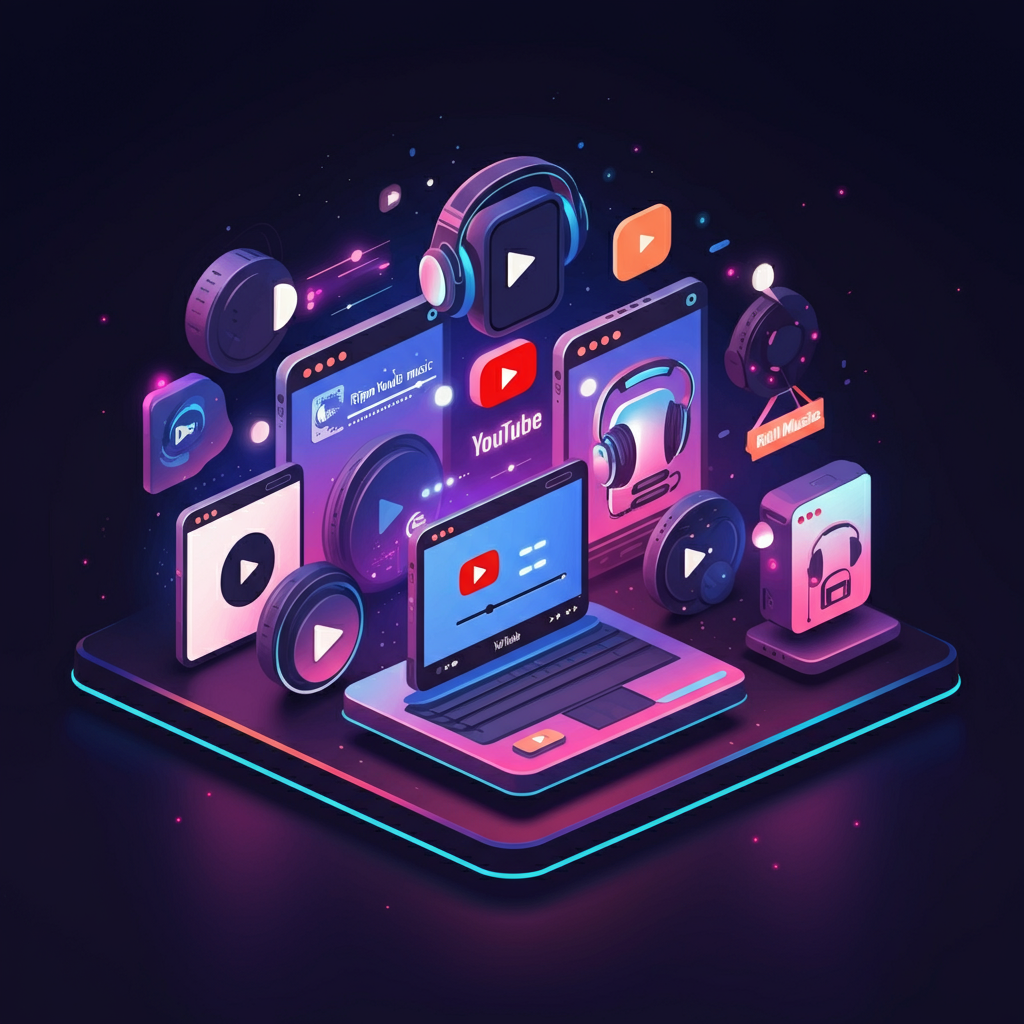Saas Tools
|
24 June 2025
How to Rip Music from YouTube Legally and Safely in 2025
Written by Faizan
Full Stack Developer
Discover the best tools and methods to rip music from YouTube, including online converters, software, and browser extensions. Learn how to stay legal and ensure high-quality downloads.

Table of Contents
Are you looking to extract audio from YouTube videos for offline listening or creative projects? The process of ripping music from YouTube can be simple and effective if you use the right tools and methods.
This guide will walk you through the best ways to rip music from YouTube, explain the legality of doing so, and highlight the pros and cons of different methods. We'll also provide actionable steps and explore related keywords like “YouTube audio extraction,” “convert YouTube to MP3,” and “download YouTube music” to ensure you have all the information you need.
What Does It Mean to Rip Music from YouTube?
Ripping music from YouTube involves extracting audio from videos and saving it as standalone audio files in formats like MP3 or WAV. This is handy for:
- Offline listening
- Creating custom playlists
- Using soundtracks for personal projects
However, it’s essential to adhere to copyright guidelines when downloading and using any content from YouTube.
Methods to Rip Music from YouTube
There are several methods to rip music from YouTube, depending on your needs and budget. Each method has its pros and cons, which we’ll cover below.
1. Using Online Tools
Online platforms provide an easy and quick way to rip audio without installing software. Examples include Y2Mate, YTMP3, and Keepvid.
Steps to Rip Music Using Online Tools:
Copy the YouTube video URL.
Go to a converter website like Y2Mate or OnlyMP3.
Paste the URL into the tool’s input field.
Select your preferred audio format (e.g., MP3).
Click “Convert” and download the audio file.
Pros:
- No software installation required.
- Free options available.
- Simple and user-friendly.
Cons:
- May have ads and pop-ups.
- Output quality might be limited.
- Risk of accessing unreliable or unsafe sites.
2. Using Software Programs
For high-quality audio and advanced features, software programs like Audacity and 4K Video Downloader are excellent options.
Popular Software Tools:
- Audacity (Free): An open-source audio editor that lets you record and manipulate audio.
- 4K Video Downloader (Paid): A reliable tool for downloading high-quality videos and converting them to MP3.
Steps to Use Audacity:
Install Audacity and the FFmpeg library on your computer.
Open Audacity and set input to “Windows WASAPI” (or the equivalent for your OS).
Play the YouTube video and record the audio in real-time using Audacity.
Save the file as MP3 or WAV.
Steps to Use 4K Video Downloader:
Download and install the software.
Copy the URL of the YouTube video.
Paste the URL into the downloader tool.
Select the audio format, quality, and download location.
Click “Extract” to save the file.
Pros:
- Superior audio quality.
- Customizable settings.
- Additional tools for editing and file management.
Cons:
- Some tools require payment.
- Installation can be time-consuming.
3. Using Browser Extensions
Browser extensions like Notta and YouTube Audio Downloader integrate directly with your web browser.

Steps to Use Extensions:
Install the extension from the Chrome Web Store or your browser’s marketplace.
Open YouTube and start playing the desired video.
Use the extension to extract and download the audio.
Pros:
- Convenient for frequent use.
- Provides a one-click solution.
Cons:
- Limited compatibility with updates in YouTube’s security measures.
- Extensions may not work with every video.
4. Manual Recording
If you want complete control or need to extract audio from private or restricted videos, manual recording is an option.
Steps to Manually Record Audio:
Use built-in tools like Voice Recorder on Windows or QuickTime Player on Mac.
Play the YouTube video.
Record the audio in real time.
Save the recording as an MP3 or WAV file.
Pros:
- Works with private or restricted content.
- No need for external software.
Cons:
- Time-consuming.
- Lower audio quality compared to dedicated tools.
Is It Legal to Rip Music from YouTube?
Legality is a crucial aspect of ripping music. Downloading copyrighted content without authorization violates YouTube’s Terms of Service and copyright laws.
Legal Scenarios for Audio Extraction:
- Public Domain: Content free from copyright restrictions.
- Creative Commons Licenses: Videos where creators have permitted downloading or repurposing.
- Your Own Content: Downloading audio from videos you own or have uploaded.
Tips to Stay Legal:
- Always check the copyright status of the content.
- Look for videos marked as royalty-free or public domain.
- Avoid sharing or distributing extracted audio unless you have the rights to do so.
Pros and Cons of Ripping Music from YouTube

Here are the general advantages and disadvantages:
Pros:
- Saves bandwidth compared to streaming.
- Allows offline listening and customization.
- Useful for personal projects or creating playlists.
Cons:
- Risk of copyright infringement.
- Quality of extraction varies based on the method.
- Some tools may contain ads or unsafe software.
Choosing the Right Format for Audio Files
When ripping music from YouTube, you can typically choose between MP3 and WAV formats. Here’s a quick comparison:
FormatProsCons
MP3:
- Pros: Smaller file size, universally compatible.
- Cons: Lossy compression.
WAV:
- Pros: High-quality, lossless audio.
- Cons: Larger file size.
Actionable Steps to Rip Music Safely
Choose a reliable tool (e.g., Y2Mate for quick tasks, Audacity for advanced needs).
Verify the copyright status of the video being ripped.
Use antivirus software to secure your device from threats.
Organize your downloaded audio files by naming and tagging them properly.
Tools to Try Today
Here are some trusted options to get started:
- Y2Mate: A popular online converter.
- Audacity: Free software for audio editing.
- Notta Chrome Extension: A browser extension for quick audio extraction.
- TunePat YouTube Music Converter: A paid solution with advanced features.
Final Thoughts
Ripping music from YouTube is a practical way to enjoy your favorite tracks offline or for personal projects. By choosing the right method and respecting copyright laws, you can extract YouTube audio safely and efficiently.
Whether you prefer the ease of online tools, the high-quality output of software programs, the convenience of browser extensions, or the flexibility of manual recording, there’s a solution for everyone.
Now that you know the best methods and tools, why not try one today to build your personalized audio library? For more tips and tools on working with audio files, explore the Convert YouTube to MP3 Converter.
Related FAQs
- Can you rip music from YouTube legally?
- Yes, if the video is public domain, Creative Commons-licensed, or your own content.
- What is the best free tool for YouTube audio extraction?
- Y2Mate and OnlyMP3 are reliable options for quick, free tasks.
- How do I ensure high-quality audio extraction?
- Use software like Audacity or 4K Video Downloader and select the highest available quality settings.
FAQ About Ripping Music from YouTube
1. Is it legal to rip music from YouTube?
It depends on the content. Ripping videos marked as public domain, royalty-free, or Creative Commons-licensed is legal. However, downloading copyrighted material without permission is against YouTube's Terms of Service and copyright laws.
2. What tools can I use to rip music from YouTube?
Here are some popular tools:
- Online tools like Y2Mate and OnlyMP3.
- Software programs such as Audacity and 4K Video Downloader.
- Browser extensions like Notta.
- Make sure to only use tools from reputable sources.
3. Which audio format should I choose after ripping music?
- MP3: Best for everyday use, smaller file size, and universally compatible.
- WAV: Ideal for high-quality, lossless audio but takes up more storage.
4. Can I rip music from YouTube for free?
Yes, many online tools and software programs offer free options, such as YTMP3 and Audacity. However, free tools may have ads, limited features, or quality restrictions.
5. How can I ensure good audio quality while ripping music?
- Choose the highest video quality as the source.
- Use tools that offer high-quality output, like 4K Video Downloader.
- When converting, select settings for minimum compression (e.g., 320 kbps for MP3).
6. Can I use a smartphone to rip music from YouTube?
Yes! Many online tools, like SnapInsta.io, work on mobile devices. You can also use apps like SnapTube for Android or Safari-based converters for iOS.
7. Why does the audio quality drop after extraction?
This could happen if:
- The source video has low-quality audio.
- The tool you used applies heavy compression.
- To fix this, choose a higher-quality source and use a tool offering lossless formats like WAV or FLAC.
8. What should I do if a ripping tool isn’t working?
- Check your internet connection.
- Clear your browser cache if you’re using an online tool.
- Update the tool or try a different one.
- If the issue persists, consider using a software program like Audacity.
9. Are these methods safe for my devices?
Yes, if you stick to reputable tools and download them from official websites. Avoid third-party tools or sites with excessive ads or pop-ups as they might harbor malware.
10. Can I rip entire YouTube playlists?
Yes, but only some tools, like 4K Video Downloader or TunePat, support playlist downloads. Free options typically allow ripping one video at a time.
11. How can I organize the extracted music files?
- Use consistent file naming for easy identification.
- Tag files with metadata, like track names and artists, using tools like Audacity.
- Group files into folders by playlists, albums, or genres for better organization.
12. Can I rip music from YouTube Music instead of regular YouTube?
Yes, tools like TunePat YouTube Music Converter specialize in ripping music from YouTube Music.Ensure you comply with copyright restrictions when using these tools.
Revolutionize Your Workflow with Transcripter
Ready to streamline your content creation?
